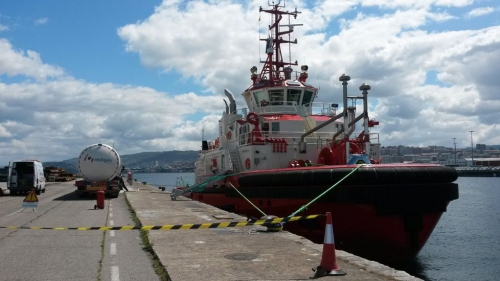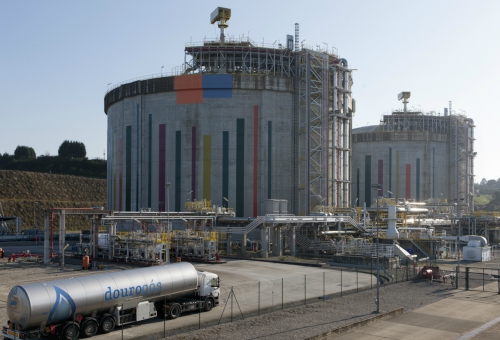Spanish Fishing Fleet Eyed as Market for Marine LNG
Reganosa, operator of the LNG import terminal at Mugardos in northwest Spain’s Ferrol area, sees prospects for developing LNG as a marine fuel for the region’s fishing fleet.
Carlos Vales, Reganosa's Production Manager, told NGE in a recent interview: "We are working hard to develop bunkering operations. One possible market is Galicia’s fishing fleet with over 4,000 boats, some small, but all kinds of sizes."
The Finistere shipping corridor, just offshore Mugardos, is used by over 40,000 ships, said Vales.

A ship being supplied with LNG by a road tanker at the port of Vigo (Photo credit: Reganosa)
Reganosa is undertaking a feasibility study into a possible 10,000 m3 capacity LNG bunkering ship, he said, that would be able to perform ship-to-ship refuelling. An investment decision had yet to be taken, so it was unclear if Reganosa would order the ship itself, or work with another investor. He declined to estimate the cost of such a ship.
Already Reganosa can refuel ships in the port that require 15,000 m3 or more, but it is now studying the possibility of having a smaller jetty where more modest LNG bunkering could be performed.
Vales admitted that northern Europe was ahead in marketing LNG as a ship’s fuel, but said that Spain wanted to "join the queue," adding: "We hope this market will grow exponentially in the next few years." Reganosa notes there are protected harbours near its terminal at Vigo, Ferrol and Coruna and so sees itself as well-positioned in the Atlantic, certainly relative to Portugal with its far fewer sheltered harbours.
Emissions control areas are expanding to southern Europe, so even cash-strapped fishing boats must consider switching to diesel or lower-sulphur LNG, and some may build a-new rather than retrofit. The extent to which public grants are available will be a factor influencing fishing vessel owners.
Just as Reganosa wants to organise an LNG distribution hub for the Atlantic coast of Spain, so Spain’s main gas pipeline and LNG terminals operator Enagas aims to do so on the Mediterranean coast.
Enagas CEO Marcelino Oreja and Port of Barcelona president Sixte Cambra signed an agreement June 1 to convert the Port of Barcelona into an LNG distribution hub in the Mediterranean.
Worldwide, Enagas estimates that over 100 ships worldwide will use LNG as their bunker fuel. Both it and Reganosa are among over 40 entities in the EU-funded ‘Core LNGas Hive’ project group that is seeking to coordinate the offer of LNG as a marine fuel to the shipping sector.
Further south in the Mediterranean, the port of Valencia also wants a role in LNG distribution; on March 16 it held a one-day conference that heard too from Portugal’s Madeira Port Authority how LNG could be used not just as a marine fuel, but also as a fuel for trucks and heavy machinery in Iberia.
Likewise, Reganosa said on May 25 it loaded 7,000 road-trucks with LNG in 2015 that were sent to 140 depots across northwest Iberia that serve the road transport and industrial sectors. Vales says this includes supplying LNG by truck to tug-boats operating in the port at Vigo.
Spain’s existing six large operating LNG import terminals and Portugal’s one at Sines thus hope that such new markets will make up for a loss of income from LNG cargo re-exports to South America and Asia, which dried up early in 2014.

Reganosa fills 7,000 road-trucks with LNG each year; this truck belongs to Portuguese supplier Dourogas (Photo credit: Reganosa)
Reganosa also hopes to improve revenues by expanding its provision of gassing-up or cool-down services to large ocean-going LNG carriers. Since 2010, there have been 50 such operations at its terminal. Of these, 17 since 2012 have been provided under a streamlined process – whereby shipowners only have to sign one contract with the Ferrol shipbuilder Navantia, which then coordinates with supplier Gas Natural Fenosa and the Reganosa terminal on how this is performed.
Vales says each ship might typically need such an operation once every 4 or 5 years. The advantage is that, if a ship has been repaired by Navantia, they don’t need to cross the Atlantic to a producer country like Trinidad in order to source LNG for cool-down – but instead can source it near at hand.
Mark Smedley | www.naturalgaseurope.com




